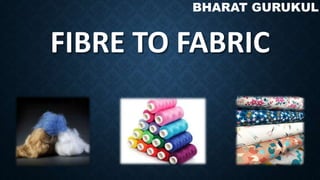
Fibre to Fabric: From Cotton Balls to Clothing
- 1. FIBRE TO FABRIC BHARAT GURUKUL
- 4. FIBRE TO FABRIC Fiber Yarn Fabric
- 6. YARN/ THREAD- • Yarn/ Thread- Hair like substance that is the basis of all yarns and fabrics.
- 7. FIBRE • The thin strands of thread that are made up of still thinner strands called fibres. • Fabrics are made up of yarns and yarns are further made up of fibres.
- 8. DO IT BY YOURSELF
- 9. Where do these fibres come from?
- 10. SOURCE OF FIBRES • There are two sources of fibre- 1. Natural and 2. Human made • The fibers of some fabrics such as cotton, jute, silk and wool are obtained from plants and animals. These are called natural fibres. Cotton Jute Silk Wool
- 11. ANIMAL FIBRES •WOOL • Wool is obtained from the fleece of sheep or goat also from the hairs of rabbits, yak and camel.
- 12. •Silk • Silk fibre is drawn from the cocoon of silk worm. • Silk worm lives on the leaves of mulberry plants. • The larva of silk moth secretes a sticky fluid which becomes silk fibre. • The larva covers its body with silk fibre and turns into pupa. This protective covering is called as cocoon. • These cocoons are then boiled in water to get silk fibre.
- 13. SYNTHETIC FIBRES • Fibres are also made from chemical substances, which are not obtained from plant or animal sources. These are called synthetic fibres. • Examples- polyester, nylon, acrylic. Nylon Polyester Acrylic
- 16. Where does this cotton wool come from?
- 17. SOME PLANT FIBRES • Cotton • Cotton is grown in the fields. • Cotton plants are usually grown at places having black soil and warm climate. • Fruit of the cotton plant are about the size of a lemon. • After maturing, the balls burst open and the seeds covered with cotton fibers can be seen.
- 18. • From these cotton balls, cotton is usually picked by hand. • Fibres are then separated from the seeds by combing this process is called ginning of cotton.
- 19. QUESTION FOR YOU •Name some states of our country where cotton is grown?
- 20. • Jute • Obtained from stem of the jute plant. • Cultivated during rainy season • In India jute is mainly grown in West Bengal, Bihar and Assam. • It is normally harvested when it is at flowering stage. • The stem of the harvested plants are immersed in water for a few days. • The stem rot and fibers are separated by hands.
- 22. FIBRE TO YARN • To make fabrics all these fibres are first converted into yarn
- 23. SPINNING COTTON YARN • Spinning- the process of making yarn from fibres is called spinning. • A simple device used for spinning is a hand spindle also called takli. Takli
- 24. • Another hand operated device used for spinning is charkha. • Spinning of yarn on a large scale is done with the help of spinning machines. • After spinning yarns are used for making fabrics. Charkha Spinning by machine
- 25. YARN TO FABRIC Two main process of making fabric with yarn are 1. Weaving 2. Knitting • Weaving- the process of arranging two sets of yarns together to make a fabric is called weaving. • Weaving of fabric is done on looms the looms are either hand operated or power operated.
- 26. • Knitting – in knitting a single yarn is used to make a piece of fabric. • Knitting is done by hand and also on machines.
- 27. What materials people used in ancient times for clothes?
- 28. HISTORY OF CLOTHING MATERIAL • Early man used bark and big leaves of trees or animal skin and furs to cover their bodies. • After that they learnt to weave twigs and grass into mats and baskets. Vines, animal fleece or heir were twisted together into long strands these were woven into fabrics. • The early Indians wore fabrics made out of cotton. In ancient Egypt cotton and flax were used for making fabrics. • But in those days stitching was unknown. People simply draped the fabrics around their bodies. Even today unstitched clothes like sarees, dhotis, lungis or turbans are widely in use. • When sewing needle was invented people learnt how to stitch fibres to make fabric. Stitched clothes have gone through many variations since this invention.
- 29. HISTORY OF CLOTHING MATERIAL
- 30. SUMMARY Cotton balls Fibre Yarn Fabric Ginning Spinning WeavingKnitting